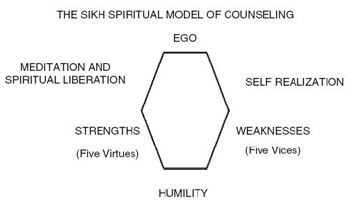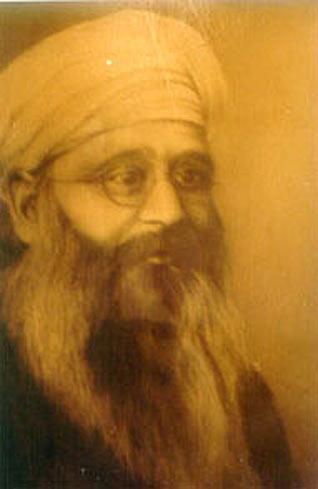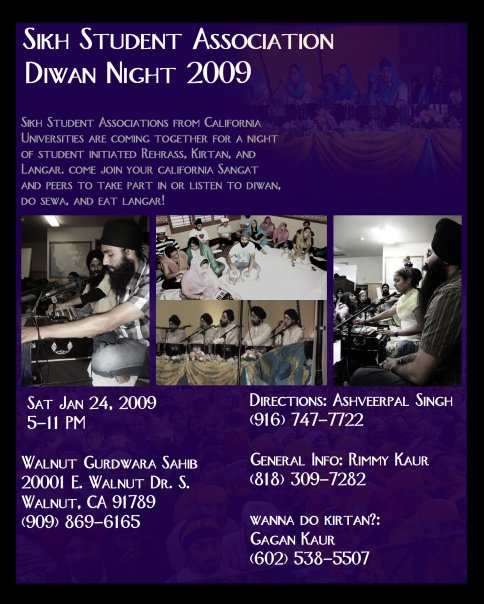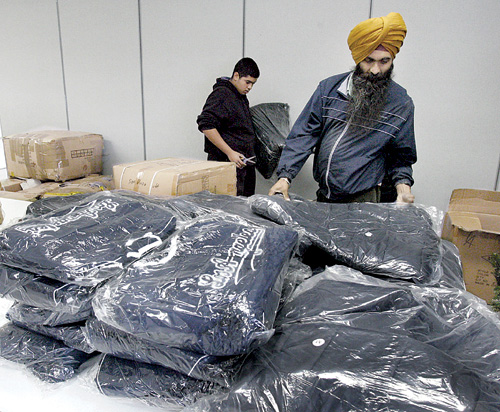
I don’t know if it’s actually appropriate to say “Happy Hola Mohalla” or “Happy Sikh New Year” (doubt it) but these are the awkward felicitations we’re going to have since we blog in English…
According to the Nanakshahi calendar (a solar calendar which begins on what’s understood to be the day of Guru Nanak’s birth in 1469), the new year is approaching. New Year’s Day falls on March 13th of the Gregorian (Western) calendar. And Hola Mohalla, which is celebrated according to the Indian (lunar I think) calendar was celebrated today (March 11) in Anandpur Sahib. Too many calendars.
I had the immense pleasure of going to a Hola Mohalla a few years ago and have to admit that it was thrilling. The roads leading to Anandpur Sahib were teeming with Sikhs from all over Punjab, and some from further parts of the country. Buses came fully loaded, as did tractors and trucks with their backs open and passengers sitting inside, outside, and on top. Many people walked, some barefoot, from incredible distances. The roads were lined with sevadars serving langar to all the weary travellers- cha, samosay, cholay, pakoray! My mouth is watering at the memory… It was an amazing celebration and feeling of community. Gatka was fought, poetry was recited, and Holi revelers threw colors at anyone within range (such is the blend of celebrations in India… maybe everywhere for that matter).
Nihangs gathered to show off their weapons, athletic prowess and fighting techniques. Men of all ages- young and old- rode two horses at a time at full speed, standing up, (a few who had had too much bhang fell) down a long grassy field with the foothills that once gave their ancestors refuge from battle in the backdrop. It was easy to imagine that it was 300 years ago and these Nihangs (except the ones who fell from too much bhang) were preparing for a real battle.
[some more pictures below the fold]
As I was randomly going through youtube clips a few days ago, I came across the above video of a group of Sikh children in Fremont, who learn kirtan in classical raags. Despite the poor audio, its obvious that they are good and I know this also from having heard them (and some of their contemporaries) in person – they are GOOD.
A couple of weeks ago Jodha reported on an article that brought to light the fact that Sikh children are practicing the tradition of kirtan, but what I think we didn’t discuss there is how this generation of Sikh musicians has really become one of classical musicians, learning stringed instruments of old and performing keertan in the Classical or raag framework. The growth has been obvious, especially in recent years – with the rise of institutions such as the The Raj Academy in Great Britain and the Gurmat Sangeet Department at Punjabi University Patiala, which specialize in providing instruction in traditional (classical) kirtan, and even the Miri Piri Academy in Amritsar of which the Chardi Kala Jatha (classically trained professional Sikh musicians who happen to be American in nationality) is a product.
 I know, from personal experience, that Sikh student organizations are always looking for a way to “get involved” and participate in a good cause. So, when I read about a recent initiative encouraging this type of active involvement, I cheered (abeit silenty… and to myself). The Sikh Spirit Foundation is an organization dedicated to promoting sikh values through education. In line with this mission, the Foundation recently launched a contest looking for project ideas which could help sikh education or our local gurdwaras.
I know, from personal experience, that Sikh student organizations are always looking for a way to “get involved” and participate in a good cause. So, when I read about a recent initiative encouraging this type of active involvement, I cheered (abeit silenty… and to myself). The Sikh Spirit Foundation is an organization dedicated to promoting sikh values through education. In line with this mission, the Foundation recently launched a contest looking for project ideas which could help sikh education or our local gurdwaras.
Help us assist the Sikh Community. Tell us how you would spend $25,000 to improve Sikh education or your local gurduara for a chance to win an iPod!
Submit two written paragraphs explaining what you would do and how it would help the Sikh community. Ideas will be judged according to feasibility, impact and need.
The Sikh Spirit Foundation intends to pursue the winning idea this summer by inviting the global community to submit proposals for the project. The Foundation will select and fund the best proposal among the submissions. [link]
Some of the organization’s grantees include: Ensaaf, Gyan Sewa Trust, Nanakshahi, Sikh Coalition, SikhNet, Sikh Research Institute, and Ujjaldidar Singh Memorial Foundation.
We’ve previously discussed involvement in the Sikh cause and lac(k)tivism – so it would be great to hear how youth and student organizations take the opportunity to suggest solutions to problems in gurdwaras and provide ideas for improving sikh education. Whether we acknowledge this or not, we are building a world today where our children will live tomorrow. To see the positive impact, it really comes down to how much we are willing to invest in our community today. We encourage you to go directly to the website to read submission guidelines – however, if you’d like to leave some thoughts here too – we’d love to hear your ideas!
 Not in India! In India, the state only engages in what is euphemistically called “fake encounters.” While many in the Sikh community remember the tragic events of 1984, in many ways the events did not just transform the Sikh nation, but has had a lasting effect on the Indian state.
Not in India! In India, the state only engages in what is euphemistically called “fake encounters.” While many in the Sikh community remember the tragic events of 1984, in many ways the events did not just transform the Sikh nation, but has had a lasting effect on the Indian state.
Rarely do I see this line of questioning amongst Indian academics, elite, or the media. Violence does not only affect the victim, but the perpetrator is also transformed. Last week, I commented on one such transformation in the Indian State – when a mainstream journalist can openly call for “state terror(ism)” as a tactic to perpetrate against its own citizenry.
This week, in a related story, but still somewhat different, I highlight the euphemism “fake encounter”. Although this term had traction before 1984 and was one of the spearheads against which Baba Jarnail Singh Bhindranwale fought against, it was in the post-1984 Punjab that supposed “encounter deaths” became so widespread and with a complacent Indian press parroting the State’s reports soon found them relegated to back pages. If there truly is a “Punjab lesson”, it was that other Indian State agencies could engage in these “fake encounters” with complete impunity. The latest case comes from the state of Chhatisgarh and the rural areas near Singaram.
 Despite the rich linguistic flexibility of Punjabi, it is telling that we do not have a single term for ‘depression.’ Mental health has been an ongoing conversation since the inception of the blog, repeatedly highlighted by Sundari and others. Often treatment is not sought and if it is sought it is usually terminated early as clients do not feel health professionals understand their world-view.
Despite the rich linguistic flexibility of Punjabi, it is telling that we do not have a single term for ‘depression.’ Mental health has been an ongoing conversation since the inception of the blog, repeatedly highlighted by Sundari and others. Often treatment is not sought and if it is sought it is usually terminated early as clients do not feel health professionals understand their world-view.
While we have numerous issues facing the Sikh community, there are few channels for those seeking mental health assistance. Thus, I was happily surprised when I came upon a medical article, titled “The Sikh Spiritual Model of Counseling.”
I reproduce the abstract in its entirety:
In accordance with the holistic principles of modern medicine, this paper will present the Sikh religious and spiritual view of mental health. With the continuing migration of a large number of South Asians, especially the Sikhs, to Western countries, mental health professionals should be aware of their clients’ world-view and cultural/religious specifi c models of counseling. Use of Sikh spirituality can reduce stress; help in treating psychosomatic disorders; and improve mental health of the individual and of the community. This paper will conclude that as the Sikh religion is a universal religion, everyone can use Sikh spirituality.
Dr. Kala Singh, the author of the article, is a physician that works as a multicultural mental-health liaison at Vancouver Coastal Health. I also want to personally thank the author for sending me a copy of his article!
As the 25th anniversary of “1984” approaches us, TLH posts have covered some activities commemorating this devastating time in our history.
My most vivid memories of “1984” are watching Indira Gandhi’s funeral on television and the border of photos inside my local Gurdwara’s Langar Hall of the men who had been tortuously killed during the Khalistani movement. As I got older, I always wondered how Sikh women were impacted by these events, aside from the infamous photo of a widow crying with her child in her arms.
I read about a woman who was strongly involved in the Sikh student movement in Punjab but now lived on the East Coast (USA). At the Fremont Gurdwara, I remember the single picture of a woman who helped make the border of Shaheeds’ photos hung high in the Langar Hall. I recall the emotional testimonies of widows left deserted by our community and the Indian government in the film, “Widow Colony”. Most recently, I came across this poem, “Don’t Feel Sorry For Me, I Am The Daughter Of A Shaheed” written by woman who lost her family in the 1984 riots in Delhi.
The conflict between modern ideals of beauty and the requirements of the Sikh faith came up in a prior post. Recently, Sukhmandir Kaur Khalsa spoke eloquently on this issue in an Arkansas publication. Excerpted below are Khalsa’s perspectives on hair, beauty, and truth.
“I liken the inherent programming of the body’s ability to grow hair to truth,” Kaur said. “Truth always asserts itself and cannot be covered for long by a falsehood. Similarly, we can shave, pluck, bleach, color, trip, tweeze, and wax hair, but it will continue to be true to its programming. The hair follicle must be killed or removed to prevent hair from appearing on the face or body. . .”
Kaur had trouble with her own self-esteem in the beginning. “I had a lot of difficulty embracing my natural identity,” she said, “until I realized through a series of experiences that I was disgracing and defacing my God-given natural beauty.”
She said she developed a high degree of self-confidence through her self-acceptance. “I realize,” she said, “that many women do not have the confidence to face the world without masking themselves with cosmetic makeup and procedures such as hair removal. . .” [link]
I have my own memories of kirtan class. During my prepubescent days, learning the harmonium was an option, but then as puberty struck this male, I quickly switched to the tabla. My days were soon coming to an end as I was entering 8th grade and I overnight, radically I came to believe I was “too cool” for such things. While at times I regretted my decision, still in a private moment near a harmonium or piano, I can still play the notes to “Jo Mange Thakur Apne Te Soi Soi Deve”.
A friend sent me a video of Harbhajan Singh [Yogi Ji] the other day. I never really listened much to Yogi Ji, but I think he makes some interesting analogies in his katha.

Here are a few that I thought were pretty cool and some that go to our previous discussions of what it means to be a Sikh. My favorite is the one that is the heading of this post:
A sikh has to practice to be the son of the Great Guru.
If we do not understand the Guru’s values, we wont survive. We can make claims. We have to have to have an understanding. Under stand. It means “stand under.” Stand under something, which is real and clear.
Somebody asked me “why we have to meditate?”
I said “why we have to take bath?”
If you don’t take bath you will stink, if you don’t meditate and chant the naam your mind will stink.
If you will not excel and serve everyone with smile and love, your soul will stink.
This past weekend at the Toronto Sikh Retreat a workshop was offered on Guru Tegh Bahadur Ji. I personally think it’s great when we are given the opportunity to delve into the lives of our Gurus. We get to see Sikhi come alive through history. Our Gurus become real as we learn about Sikh principles through their life experiences. No longer are they just pictures on the walls or names to memorize, but perfect humans who overcame personal and communal challenges. Their strong convictions and stead-fast adherence to the values of humility, patience, justice, and equality during difficult times highlights the strength of Sikhi as a practical religion than just a “philosophy”. I hope more conferences and retreats will take this approach.
During the retreat Guru Tegh Bahadur Ji’s life and bani was discussed by participants. As a young boy he was taught by Bhai Buddha Ji and Bhai Gurdas Ji. The former taught him archery and horsemanship, while the latter focused on ancient classics. Thus, Guruji was both a fighter and intellectual that had a deep appreciation for music along with the sword. The Mahima Prakash says: “Sri Tegh Bahadur was the summit of knowledge. He was a recluse at heart, a king in demour. His patience was unmatched, so was his generosity.”
 The digitization of books has created a whole new way for Sikhs to access their history. I’ve stumbled onto a lot of historical Sikh literature that I had never heard of. For example, through Google’s Book Search function, I discovered a tourist guide to Punjab from the 1880’s (here’s an excerpt on visiting Amritsar).
The digitization of books has created a whole new way for Sikhs to access their history. I’ve stumbled onto a lot of historical Sikh literature that I had never heard of. For example, through Google’s Book Search function, I discovered a tourist guide to Punjab from the 1880’s (here’s an excerpt on visiting Amritsar).
Over the holidays, I found a scanned version of a first edition of The Life and Teachings of Sri Guru Tegh Bahadur. It was written by Puran Singh and published by The Khalsa Agency in Amritsar in 1908. Puran Singh has a way with words like no other Sikh author I’ve ever encountered. His books The Spirit Born People and The Ten Masters are essential readings for anyone interested in Sikhi. In his book on Guru Tegh Bahadur he writes:
He looks upon the world with that far-seeing vacant eye with which a mariner, having lost his boat, looks upon the broad sea, seated on a rock in the middle dashed by the waves of the angry sea. The world to him is lost in the constant vision of the higher Reality of its soul. There is an intense spirit beating within his heart, which weeps ard cries at the sight of a man who is lost in the tempest of passions and remembers not the glorious life of his beyond this little life and the glorious inheritence of his in ideals of God, Love, and Truth.
He is a high abstraction in the love of God, and whenever a single thought of the world lowers his consciousness from those ethereal heights, he at once sings of God-consciousness and soars again.”Remember thy God, remember thy Lord, this is thy one duty, thy only duty,” says he.
However, what I really want to share is his opening introduction. The words are 100 years old, but just as or probably more relevant today.
In a significant development, the Government of Iraq has decided to rebuild the 15th century Sikh Guru Guru Nanak Dev’s shrine which was destroyed in the 2003 war in Baghdad. [link]
 Guru Nanak Dev Ji is said to have visited the place on his way back from Mecca where he stopped to speak with religious leaders including the caretaker of the mausoleums of Abdul Qadir gilani and Bahlol the Wise, who were greatly impressed by his views on God and religion. A monument, in the form of a platform, was raised where Guru Nanak had sat and provided these discourses. It is documented that Sikh soldiers who went to Iraq during the First World War, 1914-18, raised a Gurdwara here, but now only a room exists which is visited by Sikh and non-Sikh Punjabis who work in Iraq. In addition, it is noted that since the gurdwara is located within a graveyard, visitors are banned from staying overnight, cooking meals or holding Langar and Kirtan. I was not able to locate any information regarding who is currently in charge of the gurdwara or what the dynamics of the gurdwara are (without Langar or Kirtan). I do wonder if a Guru Granth Sahib is kept there and, in that case, who does the seva.
Guru Nanak Dev Ji is said to have visited the place on his way back from Mecca where he stopped to speak with religious leaders including the caretaker of the mausoleums of Abdul Qadir gilani and Bahlol the Wise, who were greatly impressed by his views on God and religion. A monument, in the form of a platform, was raised where Guru Nanak had sat and provided these discourses. It is documented that Sikh soldiers who went to Iraq during the First World War, 1914-18, raised a Gurdwara here, but now only a room exists which is visited by Sikh and non-Sikh Punjabis who work in Iraq. In addition, it is noted that since the gurdwara is located within a graveyard, visitors are banned from staying overnight, cooking meals or holding Langar and Kirtan. I was not able to locate any information regarding who is currently in charge of the gurdwara or what the dynamics of the gurdwara are (without Langar or Kirtan). I do wonder if a Guru Granth Sahib is kept there and, in that case, who does the seva.

Today many Sikhs in Southern California will celebrate Guru Gobind Singh Ji’s Gurpurb. When I think of Guru Gobind Singh Ji, the first thing that comes to mind is the creation of the Khalsa as an army of the pure.
This past summer I was sitting in a group-discussion, with fellow 2nd generation Sikhs (amritdhari and non-amritdhari) in the West, where we were asked to share the first thoughts that came to mind when we thought of the term “Khalsa”. Here are some:
masculine, extremists, ego, amrit, air india bombings, khalistan, rules, khandha/militaristic, collective brotherhood, fiercely independent, love, panj pyare, historical of the past & raj karega khalsa
For myself, I thought it was interesting to see how the media (i.e. newspaper articles, calendars, and television) along with the politicalization of religion and translation of Sikhi between generations is influencing our perceptions of the Khalsa.
What are your thoughts? What do you think they reflect about the state of the Khalsa?
Last night, I watched a great awards program. No it wasn’t the Emmy’s or  Grammy’s (I only know one person that watches those!). It was far more meaningful.
Grammy’s (I only know one person that watches those!). It was far more meaningful.
It is called CNN Heroes.
CNN launched its second annual global search for ordinary people accomplishing extraordinary deeds in February. The network has aired weekly CNN Hero profiles of those people, chosen from more than 3,700a nominations submitted by viewers in 75 countries.
I am sure it will be replayed to death on CNN over the next few days. It will be airing at 2pm EST on Christmas Day.
With the calendar year 2008 coming to an end (the Nanakshahi Calendar year 540 still has some time to go), I have been reflecting a bit on the subject of heroes and sheroes. I know I have blogged on some, some, some, some, and some this year.
Still I wonder who are your Sikh heroes and sheroes? Tell us who and why? I’d love to hear about those truly unheralded sheroes and heroes that do various seva with love without any expectation of recognition.
We tend to complain a lot. Really, we do. We complain about the lack of activisim by Sikh youth. We complain about not being able to understand Gurbani or be able to do Kirtan. We complain about the disconnect between Sikh elders and Sikh youth. It’s the status quo – to spend time dwelling on what’s wrong in our community rather than celebrate what’s actually going right.
However, in recent years we’ve been seeing an increased number of Sikh student or Sikh youth run events – which means it’s becoming clear that the status quo is no longer okay. I think it is not only important, but necessary, for Sikh youth to take more of an active role in their community. So it was refreshing for me to hear about this student initiated event which is being planned in collaboration with the Sikh Student Associations across California. This Diwan Night, which is to be held on January 24th 2009 in Southern California, will bring together Sikh students from across California for a night of Rehraas, Kirtan, Sewa and Langar. It’s important to support these types of initiatives and encourage Sikh youth to participate in coordinating these events. I hope this is one of many student initiated events which brings various organizations together in the hopes of actively involving youth in Sikhi.
run events – which means it’s becoming clear that the status quo is no longer okay. I think it is not only important, but necessary, for Sikh youth to take more of an active role in their community. So it was refreshing for me to hear about this student initiated event which is being planned in collaboration with the Sikh Student Associations across California. This Diwan Night, which is to be held on January 24th 2009 in Southern California, will bring together Sikh students from across California for a night of Rehraas, Kirtan, Sewa and Langar. It’s important to support these types of initiatives and encourage Sikh youth to participate in coordinating these events. I hope this is one of many student initiated events which brings various organizations together in the hopes of actively involving youth in Sikhi.
The event is on January 24th, 2009 from 5-11pm at Walnut Gurdwara. If you would like to participate in Kirtan, call Gagan Kaur at 602 538 5507. For general information, call Rimmy Kaur at 818 309 7282.
 The phone rings and its the call you dread as an uncle or older cousin. A desperate parent is on the other end asking for your help. Your teenage nephew/cousin wants to cut his hair. Can you please talk some sense into him.
The phone rings and its the call you dread as an uncle or older cousin. A desperate parent is on the other end asking for your help. Your teenage nephew/cousin wants to cut his hair. Can you please talk some sense into him.
This happened to me last week with my cousin and, I have to admit, I was woefully unprepared. While I’ve given lots of talks on Sikhi at Sikh camps and to non-Sikh audiences, I’ve never had to actually have this kind of discussion. One where I may be the determining factor in an individual’s major life decision.But what could I offer that he hadn’t already heard? How could I change the mind of a guy that’s already decided? He’s grown up in a Sikh family, his entire family keeps their hair. He has lots of Sikh friends and lives in a Sikh part of town. He should have picked up Sikhi through osmosis, but he hasn’t.
His parents have tried their best but working multiple jobs and struggling financially, putting food on the table has been their priority. And like many Punjabi Sikh parents, they’ve assumed that being surrounded by Sikh culture would be enough. So they’re shocked, betrayed, angered, hurt and deeply saddened when they’re son finally musters up enough courage to talk to them.
The Sikh blogosphere is still very young and still in its incipient phases. While one  day I hope we will have something like this (ahem, Mr.Sikhnet any takers?), for now, we will try to (at times) highlight some of the best of the blogs.
day I hope we will have something like this (ahem, Mr.Sikhnet any takers?), for now, we will try to (at times) highlight some of the best of the blogs.
SidhuSaaheb’s blog has been a favorite of mine for years. While at times disagreeing, I find his voice refreshing and a unique perspective.
His most recent post, reproduced here in its entirety below the fold, would be my vote for “post of the year.” Contrasting the most recent tragedy in Mumbai with the Sikh Pogroms of Delhi 1984, the differences are truly tragic. Please leave your thoughts on the post here as well as take a moment to visit the author’s own blog to leave your comments.
I know not whether it is an ‘old tradition‘ or a ‘family tradition’; I only know it seems to be a great tradition. Last  week, Camille bulletin board-ed a winter clothing distribution in Central California being sponsored by Mike Sandhu of Sandhu Brothers Farms.
week, Camille bulletin board-ed a winter clothing distribution in Central California being sponsored by Mike Sandhu of Sandhu Brothers Farms.
The Tracy Press published some pictures of the distribution that saw some 1200 jackets (over $50,000 in value) go out to anyone that needed. Mike stated that this was a family tradition in honor of the 2 youngest Sahibzadas.
“So we do this to keep other children, other families, warm in their honor,” he said. “It’s just something my family has done here for about six years now.”[link]
I hope that other local Sikh sangats take Mike Sandhu and the Tracy Sikh Community’s lead in making such events more regular. More than any donation of rumaals to the Gurdwara, this is one of the best ways to honor the Qaum’s shaheeds.
I like to spend winter catching up on all the reading I’ve left by the wayside, but imagine my surprise when I came across these op-eds. The first argues that the Sikh youth slate (an all amritdhari slate) that won in Surrey is “fundamentalist,” while the other article argues that Sehajdari Sikhs are, by definition, not Sikhs at all.
Both of these op-eds are a little insane to me. The first argues that the Surrey gurdwara’s prior practice of allowing uncovered heads, shoes, and tables/chairs in the langar hall somehow constituted a “moderated” practice of Sikhi, and it effectively calls for a stand against the amritdhari youth slate, which it maligns as fundamentalist, orthodox, rigid, etc. The second article argues that there is no room in Sikhi for Sehajdari individuals, and then proceeds to trace the history of in/exclusion of non-kesdari Sikhs in SGPC elections.
Deh Shiva bar mohe ihe / shubh karman the khabhu na taro
God, grant me this: that I will never refrain from righteous actsna daroo ar siyoo jab jah laro / nische kar apni jeet karo
That I will fight life’s battles without fear, and will claim victory with courageAr Sikh hao apne hi mum ko / Eh lalch hou guna tau uchroo
That you will be ingrained in my mind / with my highest ambition to sing your praisesJab aav ki audh nidhaan nane / aut hee rann me tab joojh maroo
when this mortal life comes to an end, may I fight with limitless courage
“Deh Shiva” is often described as the Sikh national anthem, and it comes to us from Dasam Granth. As a shabad, it has been invoked on the (literal) battlefield as a rallying cry and a unifying call around Waheguru. The shabad analogizes the struggle in our daily lives to overcome issues that lead us away from Waheguru to a battle — with a single-minded focus on Waheguru, we are able to transcend our attachments to the material and emotional trappings of life.
But as a shabad it has also been used in a very literal manner to mobilize Sikhs in war. As Mewa Singh mobilize action around a political (and militarized) struggle. Does a literal intepretation, or recitation, of shabad convert its meaning? I’ve always found this specific shabad empowering and elevating, but not inherently “violent” or “militant.” As a child, I always felt strangely calm and elated by the words, punctuated at each phrase with “Bole So Nihal, Sat Sri Akal!” I have always heard this shabad as a call to the nation, not as a device or tool for violence.
We’ve heard the arguments (valid and not) before about why Sikhi is a martial faith or has a martial history or a martial outlook. There are certainly religious foundations that acknowledge the real challenges faced in every day life and the need to resist oppression. Resistance eschews, but does not forbid, violence. Nonetheless, at its core I believe Sikhi is a religion of love — love of the Guru, Granth, and community, defined in the context of humankind and creation.

